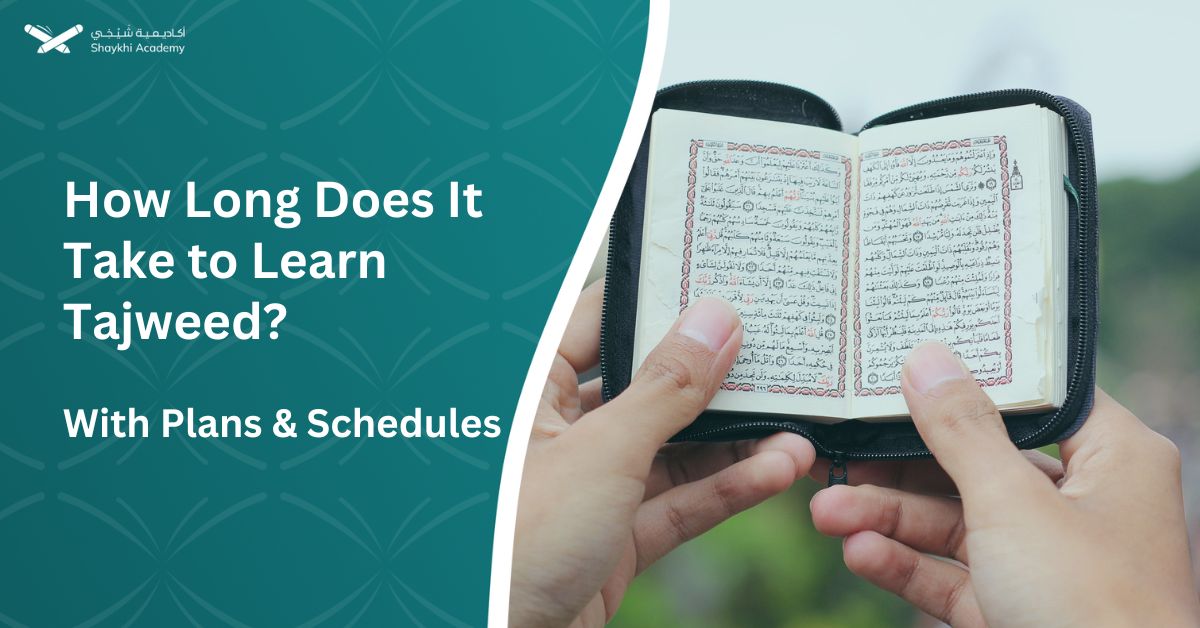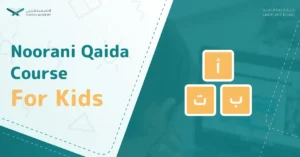How long does it take to master Tajweed? The answer is as varied as the learners themselves, ranging from a few months with intensive study to a year or more for those balancing other commitments. Whether you’re dedicating one, two, or three hours a day, a structured learning plan can guide you through the stages, from mastering the Arabic alphabet and basic rules to delving into advanced concepts like Madd, Ghunna, and Waqf.
In a nutshell, learning Tajweed can take a few months to a year or more, depending on the time commitment, prior knowledge, and learning resources. Consistent practice is key, and structured plans for one, two, or three hours a day can accelerate learning.
Beginners should focus on the Arabic alphabet and basic rules, then progress to advanced rules and practice with Surahs. Those with more time can delve deeper into articulation, unique recitations, and advanced rules.
How Long Does It Take to Learn Tajweed?
On average, it can take about 6 months to a year or more of consistent practice to get really good at Tajweed. That means understanding the rules and being able to use them smoothly when reciting the Quran. But hey, everyone learns at their own pace, so don’t worry if it takes a bit longer.
Learning the rules of Tajweed is kind of like building a foundation. It can take a few months or a couple of years, depending on how much you already know and how deeply you want to understand them. Think of it like learning the alphabet before you start reading.
Want to learn faster? Having a knowledgeable tutor is like having a personal guide. They can give you personalized feedback, correct your pronunciation, and help you grasp those tricky rules. Plus, interactive learning methods, like online classes, can make the whole process more engaging and fun!
(Consider reaching out to us for a consultation with our experienced Quran teachers at Shaykhi Academy).


Learning Plans for Tajweed Based on Time Commitment
To cater to different schedules and commitments, here at Shaykhi Academy we have prepared various structured plans for dedicating one, two, or three hours a day to learning Tajweed.

1. One-Hour Daily Plan
For those dedicating one hour a day to Tajweed, the journey might take longer but remains effective with consistent effort. Here is a detailed breakdown:
- Months 1-2: Focus on mastering the Arabic alphabet and basic pronunciation rules. Begin with the correct articulation points (Makharij) and characteristics of letters (Sifat).
- Months 3-6: Study the fundamental Tajweed rules such as Idgham (merging), Ikhfa (concealment), Iqlab (conversion), and Qalqalah (echoing). Start applying these rules in short Surahs.
- Months 7-9: Move on to more advanced rules like Madd (elongation), Ghunna (nasalization), and the rules for stops (Waqf). Increase practice with longer Surahs.
- Months 10-12: Focus on achieving fluency and mastery. Practice reciting entire chapters of the Quran with proper Tajweed, and seek regular feedback from a tutor.
Here’s a table for this structured plan:
| Stage | Focus Areas | Duration |
| Month 1-2 | Arabic alphabet, basic pronunciation rules | 2 months |
| Month 3-6 | Fundamental Tajweed rules (Idgham, Ikhfa, etc.) | 4 months |
| Month 7-9 | Advanced Tajweed rules, practice with short Surahs | 3 months |
| Month 10-12 | Mastery of pronunciation, fluency in recitation | 3 months |
2. Two-Hour Daily Plan
A two-hour daily commitment significantly accelerates the learning process. Here is a detailed breakdown:
- Month 1: Intensive study of the Arabic alphabet and basic pronunciation rules, focusing on proper articulation and characteristics.
- Months 3-4: Learn and apply fundamental Tajweed rules. Practice with short Surahs, ensuring the correct application of the rules.
- Months 5-6: Delve into advanced rules and apply them in longer Surahs. Regular practice sessions should be held to reinforce learning.
- Months 7-8: Achieve fluency in recitation by practicing entire chapters. Regular feedback from a tutor is essential to correct mistakes and improve accuracy.
This plan provides a more intensive schedule:
| Stage | Focus Areas | Duration |
| Month 1 | Arabic alphabet, basic pronunciation rules | 1 month |
| Month 2-4 | Fundamental Tajweed rules (Idgham, Ikhfa, etc.) | 3 months |
| Month 5-6 | Advanced Tajweed rules, practice with short Surahs | 2 months |
| Month 7-8 | Mastery of pronunciation, fluency in recitation | 2 months |
3. Three-Hour Daily Plan
For the most rapid progress, a three-hour daily study schedule is ideal. This immersive approach can lead to proficiency within a shorter timeframe:
| Stage | Focus Areas | Duration |
| Month 1 | Study correct pronunciation of Arabic letters, focus on details such as Tafkhim (emphasis) and Tarqiq (lightness). Introduction to rules of Noon Sakinah and Tanween (Izhar, Idgham, Iqlab, Ikhfa) | 1 month |
| Month 2 | Learn the basic principles of Tajweed, practical applications of rules for Noon and Meem Sakinah, and Tanween. Detailed study of the different types of Madd (elongation) with Quranic examples | 1 month |
| Month 3-4 | Advanced study of articulation points and proper letter pronunciation (Makharij). Advanced understanding of the attributes of letters (Sifaat) | 2 months |
| Month 5-6 | Mastery of advanced Tajweed rules, including rules of stopping and starting (Waqf and Ibtida), understanding the unique aspects of Hafs recitation compared to other Quranic recitations | 2 months |
Foundational Stage:
- Arabic Alphabet: Master the correct pronunciation and subtleties of Arabic letters quickly.
- Basic Tajweed Rules: Intensive study of the fundamental rules of Tajweed.
- Application: Daily recitation practice focusing on short Surahs.
Intermediate Stage:
- Expanded Rules: Comprehensive study of Madd rules with daily practice.
- Articulation Points: Focus on perfecting the articulation points and letter characteristics.
- Application: Practice with medium-length Surahs for thorough understanding.
Advanced Stage:
- Advanced Rules: Detailed study of advanced Tajweed rules, including Waqf and Ibtida.
- Hafs Recitation: In-depth study of Hafs ‘an Asim recitation, emphasizing unique aspects.
- Practice: Extensive recitation of longer Surahs, aiming for fluency and precision.

Important Notes:
- These are just examples. Adjust your plan based on your progress and learning style.
- Combine self-study with guidance from a tutor or structured course for optimal results.
- Don’t get discouraged if you need more time.
Factors Influencing Your Tajweed Learning Timeline
Learning Tajweed is a journey, and the time it takes is different for everyone. Here are some things that affect how long it’ll take you.
Firstly, if you already know the Arabic alphabet and how to pronounce the letters, you’re ahead of the game. It’s like learning a new language – knowing the basics speeds things up.
Secondly, how much time can you carve out for practice? Just like anything else, the more you do it, the better you get. Even short, regular sessions are better than cramming it all in.
We all learn differently, too. Some people are like sponges, soaking up the Tajweed rules quickly. Others need a bit more time and repetition. There’s no right or wrong way, so find which learning style works for you.
Having a good teacher can be a game-changer, a good teacher can make a big difference, but if you’re disciplined and have the right resources, you can definitely learn on your own.
Finally, what are you aiming for? Do you want to be a Tajweed pro, or just want to recite the Quran more beautifully? Your goals will shape your learning journey.
It’s an exciting journey, our brother. Take it at your own pace, enjoy the process, and before you know it, you’ll be reciting with confidence and ease!
Master Tajweed Faster: Your Personalized Plan Awaits at Shaykhi Academy
Curious how long your Tajweed journey might take? Wondering how to structure your learning for maximum efficiency?
Our Online Tajweed Course is designed to get you reciting beautifully and confidently, no matter your starting point.
By joining us, you’ll gain access to:
- Structured Learning Paths: Tailored schedules to help you progress steadily and confidently.
- Personalized Feedback: Expert guidance to pinpoint areas for improvement and accelerate your mastery.
- Proven Techniques: Streamlined methods to optimize your learning and achieve results faster.
Don’t leave your Tajweed journey to chance. Discover the best path to Quranic mastery with Shaykhi Academy.
Discover Our Range of Courses:
- Arabic Noorani Qaida: Lay a solid foundation for Quranic studies.
- Online Quran Classes for Kids: Engaging lessons for lifelong learning.
- Tajweed Rules for Kids: Learn to recite with confidence.
- Quran Hifz for Kids: Step-by-step guidance to memorize the Quran.
- Quran for Adults: Introduce yourself to Quran reading and Tajweed rules.
- Online Arabic Courses: Master the language of the Quran.
- Islamic Studies: A wide range of topics related to Islam, including theology, law, Quranic studies, Hadith.
Don’t Miss Out on Your Chance to Excel!
Start Your Tajweed Journey Today! Enroll Now in Shaykhi Academy’s Online Tajweed Course

Conclusion
Learning Tajweed is a continuous journey of dedication and practice. While the average time to achieve proficiency ranges from 6 months to 1 year with a commitment of 2 hours per day, the actual duration depends on individual factors such as prior knowledge, learning aptitude, and the quality of instruction.
By following structured learning plans and maintaining consistent practice, learners can make steady progress and master the art of Quranic recitation with Tajweed.
Whether you dedicate one hour or three hours a day, the key to mastering Tajweed lies in regular practice, quality guidance, and a genuine passion for learning. Consistent effort and dedication will lead to success in your Tajweed journey, enabling you to recite the Quran with accuracy and beauty.




















